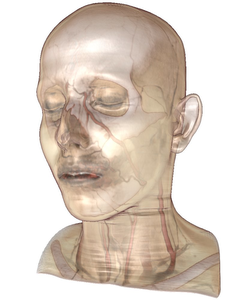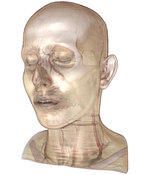Information
- Publication Type: Master Thesis
- Workgroup(s)/Project(s):
- Date: 2005
- TU Wien Library:
- First Supervisor:
Abstract
Volume rendering techniques for medical applications face a number of problems that restrict the applicable techniques to a handful of established algorithms. Developing a virtual endoscopy application further narrows the choice due to the very specific demands of such a system. First, being able to move the viewpoint into the dataset and providing correct renderings incorporating the wide field of view optical endoscopy cameras usually deliver is a challenging task at a time when many of the available professional solutions like TeraRecon’s VolumePro boards are still restricted to orthogonal rendering. Second, the extreme perspective distortion of the image leads to an amplification of visible sampling artefacts, making it necessary to employ special techniques to deal with this problem. Third, highly interactive framerates are not a welcomed feature but an absolute necessity, since the possible intra-operative environment makes immediate response to certain actions essential. And last, correct visualization and intersection of the endoscopic tools have to be ensured in order to provide the surgeon with an adequate representation of the environment. In the past, there has always been a trade-off between functionality, interactivity and high-quality renderings resulting in systems either being able to produce interactive visualizations that lack the necessary detail and correctness of the representation, or high-quality renderings that have to be generated off-line in a tedious process that makes real-time adaptations impossible. This thesis presents an approach that attempts to meet all the demands on a virtual endoscopy system by creating a rendering framework that allows for interactive framerates for almost every possible dataset, quality setting and rendering mode. To achieve this, a number of specialized techniques is incorporated that extend the basic rendering pipeline in numerous ways. As virtually all of the different approaches to real-time visualization of volume datasets, raycasting on consumer graphics hardware faces its own problems and pitfalls. This is why separate sections of this thesis are dedicated to solutions to these problems that make the approach as versatile as possible. Finally, results and real-life images of the raycaster are presented, which is already used in medical practice in pre-operative planning for neuro-surgery.Additional Files and Images
Weblinks
No further information available.BibTeX
@mastersthesis{scharsach-2005-adv,
title = "Advanced Raycasting for Virtual Endoscopy on Consumer
Graphics Hardware",
author = "Henning Scharsach",
year = "2005",
abstract = "Volume rendering techniques for medical applications face a
number of problems that restrict the applicable techniques
to a handful of established algorithms. Developing a virtual
endoscopy application further narrows the choice due to the
very specific demands of such a system. First, being able to
move the viewpoint into the dataset and providing correct
renderings incorporating the wide field of view optical
endoscopy cameras usually deliver is a challenging task at a
time when many of the available professional solutions like
TeraRecon’s VolumePro boards are still restricted to
orthogonal rendering. Second, the extreme perspective
distortion of the image leads to an amplification of visible
sampling artefacts, making it necessary to employ special
techniques to deal with this problem. Third, highly
interactive framerates are not a welcomed feature but an
absolute necessity, since the possible intra-operative
environment makes immediate response to certain actions
essential. And last, correct visualization and intersection
of the endoscopic tools have to be ensured in order to
provide the surgeon with an adequate representation of the
environment. In the past, there has always been a trade-off
between functionality, interactivity and high-quality
renderings resulting in systems either being able to produce
interactive visualizations that lack the necessary detail
and correctness of the representation, or high-quality
renderings that have to be generated off-line in a tedious
process that makes real-time adaptations impossible. This
thesis presents an approach that attempts to meet all the
demands on a virtual endoscopy system by creating a
rendering framework that allows for interactive framerates
for almost every possible dataset, quality setting and
rendering mode. To achieve this, a number of specialized
techniques is incorporated that extend the basic rendering
pipeline in numerous ways. As virtually all of the different
approaches to real-time visualization of volume datasets,
raycasting on consumer graphics hardware faces its own
problems and pitfalls. This is why separate sections of this
thesis are dedicated to solutions to these problems that
make the approach as versatile as possible. Finally, results
and real-life images of the raycaster are presented, which
is already used in medical practice in pre-operative
planning for neuro-surgery.",
address = "Favoritenstrasse 9-11/E193-02, A-1040 Vienna, Austria",
school = "Institute of Computer Graphics and Algorithms, Vienna
University of Technology ",
URL = "https://www.cg.tuwien.ac.at/research/publications/2005/scharsach-2005-adv/",
}

 PDF
PDF

